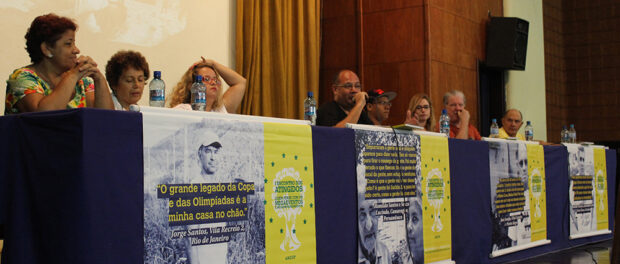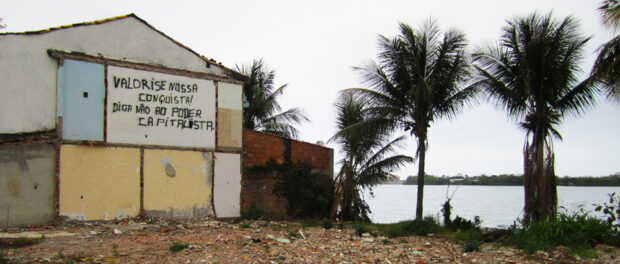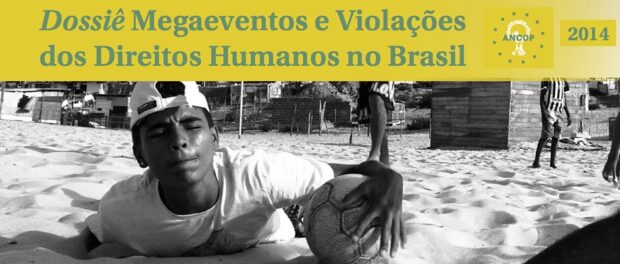
The Brazilian Press Association auditorium played host to the National Articulation of the Popular Committees of the World Cup and Olympics (ANCOP) on November 7th for the launch of the nationwide dossier entitled “Megaevents and Human Rights Violations in Brazil.” The first national dossier was published in 2011 while the Rio Popular Committee has published dossiers on megaevents and human rights violations in the city of Rio de Janeiro in March 2012, May, 2013, and July, 2014. These in-depth reports have become some of the most comprehensive documents available in evaluating the “legacy” and true impacts of the World Cup and Olympics.
Representatives from all 12 World Cup host cities’ Popular Committees were present at the launch, as well as many activists, professors, students and media. A panel spoke about the development of the dossier, the impact that the Popular Committees have had on the ground in each city and about the movement’s place in Brazilian history.
Residents from the Indiana, Vila Autódromo and Vila União favelas spoke about their fight against evictions, each case representing a different stage of resistance.
Maria do Socorro is a resident from Indiana, where residents were threatened with eviction from January 2012 onwards but have successfully resisted removal. She thanked ANCOP for its role in the organizing process: “If it weren’t for the committee, I’m not sure my community would exist….it was the committee that brought me to the street.”
Vila Autódromo resident Inalva Mendes Brito spoke of the Committees’ constant involvement and on-the-ground support as the community continues to battle eviction while work on the adjacent Olympic Park ploughs on.
Flavia, a resistance leader in Vila União and a new addition to the Rio Popular Committee, relayed that earlier that same day, the city government arrived at the Neighborhood Association and declared that residents would receive social rent allowance because there is not enough replacement public housing for all. Vila União is the latest battleground in the Olympics evictions resistance after initially having been told it would not only be able to remain but would receive Morar Carioca infrastructure upgrading.
The Dossier
The dossier is broken down into the 8 major areas of rights violations with respect to the two mega-events: Housing, Labor, Public Goods and Mobility, Sport, Environment, Budget and Finance, Information and Representation and Public Security. Small case studies from across Brazil are included throughout the eight chapters.
Housing
After providing a summary of relevant Brazilian and United Nations legislation regarding citizens’ housing rights, the dossier spells out the general strategy of eviction used by local governments. The process exhibits a lack of dialogue and transparency, often beginning with the “systemic production of misinformaton,” leading to threats and then to political and psychological pressure. Negotiations over compensation tend to be conducted with residents individually to limit their collective bargaining power. Lastly, public services are withdrawn and violent removal occurs. ANCOP conservatively estimates 250,000 Brazilians were either threatened or evicted via these tactics.
The chapter then surveys cases of eviction from across Brazil’s 12 host cities. Threatened communities were generally in the proximity of stadiums or simply alleged to be in the path of infrastructure projects. Despite some brutal stories of removal there are also many victories. One instance being the Vila Autodromo’s People’s Plan, which inspired a similar resistance in São Paulo’s Favela da Paz and allowed residents there to remain–even receiving infrastructure upgrades in the community–until housing was available nearby.
Government data on the number of people “involuntarily removed” from their homes concludes the chapter. However, these government figures are misleading. The data exclude projects not deemed “directly related” to the World Cup and exclude Olympics-related projects, which ANCOP claims in Rio’s case comprise part of the same larger process and “privatization of the right to the city.”
Labor: Poor Conditions, Intimidation, Exploitation
The dossier’s labor chapter documents violations in worker safety, persecution of labor leaders and companies’ disrespect of the right to organize, strike and protest.
Abysmal worksite conditions led to many strikes and work stoppages. As of April 2012, there had been 18 strikes across eight of the 12 stadium sites. By 2014, there had been a total of 103 days of striking. These stoppages resulted in multiple cases of worker intimidation. At four work sites companies even brought legal action and attempted to criminalize the actions of unions.
The pressure to complete projects at an accelerated pace resulted in precarious working conditions and contributed to ten deaths at stadium worksites.
Beyond these violations, FIFA and its sponsors benefited from laws allowing children above 12 years of age to work in “promotion activities” and the labor of 14,000 volunteer workers. In stark contrast, the Dossier notes that Brazilian law explicitly prohibits the employment of children under 14 and only allows volunteer work for government entities and non-profit organizations (FIFA posted $1.3b in revenue in 2013 and $72m in net profit).
FIFA’s World Cup Law also criminalized informal work in certain zones of host cities–work that comprises many Brazilians’ livelihood. This served as a way to “clean” the World Cup areas as well as ensure monopolies for sponsors. This prohibited many Brazilians from engaging in their typical line of work. In Salvador, Bahia, this led the traditional Afro-Brazilian dish acarajé to be outlawed from the Fonte Nova stadium before successful protests by the Baianas de Acarajé Association allowed them to continue their work in the area.
Public Goods and Mobility
Despite many plans being scrapped, infrastructure comprised a huge portion of the megaevent-related projects. ANCOP notes that in general, these projects tend to be bus and car-centric, are usually concentrated in specific areas of each city and increase urban inequalities. Of the 57 transport-related projects, 22 are traditional motorways that will serve cars and 14 more are motorway-BRT combinations. “In general, the proposed corredors of transport open new real estate fronts… and the irrational expansion of the urban fabric.” The Barra da Tijuca region of Rio de Janeiro is emblematic of this trend, where the real estate market is booming and these projects are helping to remake the area entirely.
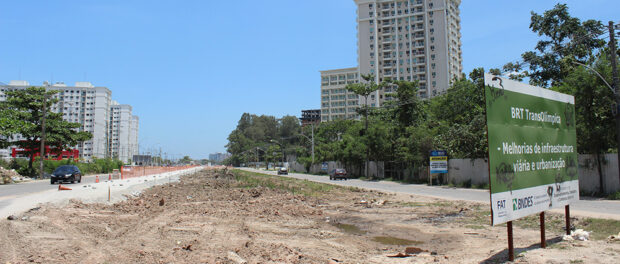
The dossier also discusses the large increases in public transport prices across Brazil, which triggered the massive protests of 2013. These increases often outpace inflation, and haven’t reflected any improvement in service, levels ANCOP. Often, these services are actually contracted to private firms as is the case with Rio de Janeiro’s Supervia commuter rail system of which 60% is owned by Odebrecht Transport and 40% by a foreign investment firm. In recent decades, families have spent more and more on transportation. In 1970 this figure was 11.2%. In 2009 families spent 19.6%, roughly the 19.8% they spent on food.
Sport: Football and Exclusivity
Beyond the exhorbitant stadium construction costs, ANCOP discusses the cultural erosion caused by soaring ticket prices. Historically, stadiums were segregated based on class but always guaranteed mass participation through thousands of affordably priced seats.
According to one study cited by ANCOP, the high prices of (and necessity of credit card and Internet connection to purchase) World Cup tickets meant that 90% of Brazilian fans were from the A and B classes (households earning between R$5,100 and R$10,200 per month) while only 6% declared themselves as Black. This represents a tectonic shift in the way Brazilians have participated in the spectacle of football.
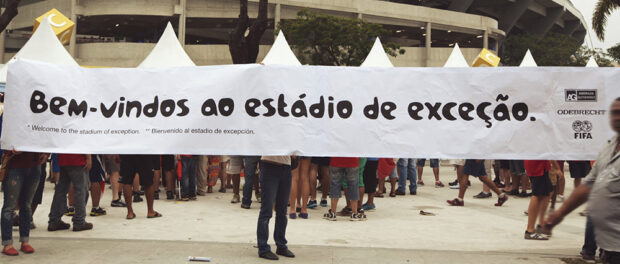
But this trend didn’t end with the World Cup and has led to the “elitization of football.” The price of Brazilian domestic league tickets increased 300% between 2003-2013. The average ticket now costs R$38 and has diminished game attendances significantly. The United States’ Major League Soccer now has a higher average game attendance than the Brasileirão championship, notes the Dossier.
As many of the stadiums have been privatized and had their capacities diminished to make room for luxury suites, the traditional “fan” has been substituted by the “consumer.” Rio’s Maracanã is the most glaring example but the process has transformed other host cities’ stadiums as well. ANCOP observes that “stadiums are becoming more similar to shopping malls, and the ticket price is the filter of access for this new consumption zone.”
Environment
FIFA and the Brazilian government both touted what was to be the “Green Cup.” The dossier examines this rhetoric closely and finds that green marketing was quite successful in legitimizing projects rather than working towards a truly green economy.
The dossier explains how the carbon credit program which claimed to compensate for the CO2 emissions of the event led to an oversupply of credits and in fact made polluting more affordable for private companies: “What we observe is the mutilation of environmental legislation, its substitution for market rules that don’t punish, but reward those who degrade the environment.”
Projects in many cities damaged preserved areas and violated environmental legislation. The amplification of the Amazon city of Manaus’ airport caused damage in an adjacent Permanent Preservation Zone, while in Salvador local authorities passed laws steamrolling federal environmental impact study requirements. In Rio environmental zoning changes were made without even consulting technical experts. Rio’s local administration altered boundaries of the Marapendi Environmental Reserve “allowing for the construction of 22 luxury apartments… and a land donation…valued at approximately R$500m.”
ANCOP asserts: “The recurring flexibilities in the name of the Cup or the Olympics hurt legally determined processes, while also putting the environment at risk.”
Budget and Financing
The dossier observes three major trends with respect to the financing of the World Cup: the almost complete transition from a privately-funded event to a publicly-shouldered one; the exorbitant growth of project costs; and the simultaneous increase in stadium spending with major decreases in transportation and infrastructure spending.
When Brazil was selected to host the World Cup in 2007, Lula promised that the private event would–appropriately–be privately financed and promised no public money would be squandered on the tournament. The dossier documents this complete reversal pointing out that in the end the only projects that were undertaken privately were airports and even these were later financed with more than R$5b from Brazil’s National Development Bank (BNDES). This shifts any risk to the public sector while the low interest loans of the BNDES are of course subsidized by taxpayer money. Beyond direct spending and financing, the Brazilian government also gave away over R$1b in tax breaks to FIFA and its sponsors.
Initally estimated to be R$1.98b, Brazil’s World Cup budget arrived at R$9.5b in 2014 when tax breaks are included: an increase of 380%. Certain cities and states spent roughly a quarter of their annual budget, including the city of Natal and the state of Mato Grosso. Mato Grosso, along with the city of Recife, could have paid off their entire debt load with the money they spent on the World Cup.
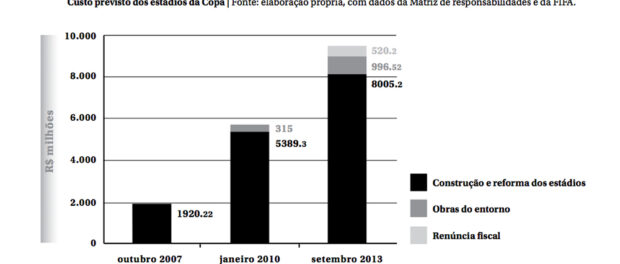
Within this huge budget expansion occured another troubling trend: the shift away from infrastructure investment and towards huge stadium outlays. As stadium budgets swelled, 21 of the original 57 infrastructure projects were cancelled and 4 host cities ended up with no urban mobility projects at all.
Information and Representation
Despite Constitutional articles and UN Resolutions to which Brazil is a signatory, a set of parallel governing bodies assembled to carry out much of the World Cup and Olympic planning have been able to undermine a truly democratic and inclusive decision-making process. The intentionally slow nature of inclusive decision-making is not compatible with the short timetable imposed on locales hosting these events.
The Dossier explains that these bodies “constitute an exceptional government, whose decisions are exempt from any form of social control.” These bodies include: the Public Olympic Authority which monitors the implementation of the Responsibility Matrix; the Management Committee of the Cup; the Executive Committee of the Cup and the Local Organizing Committee (a private entity linked to FIFA) among others.
Brazilian law was explicitly altered in the form of the World Cup Law. ANCOP sees the constitutionality of the law as “highly questionable.” The parallel legal regime of temporary laws and administrative bodies associated with the World Cup ultimately compromised Brazilians’ rights via an opaque and top-down planning and decision-making process.
Public Security
In preparation for the World Cup, the Brazilian government spent R$1.7b on security equipment and technology. This included 263,000 cartridges of rubber bullets, 270,000 grenades and tear gas projectiles, 34 anti-arial tanks, 27 robots capable of disarming explosives and 4 drones. ANCOP’s dossier links this surge in armament not only to repression of protestors and journalists, but to extensive human rights violations and killings in Rio’s favelas.
New laws associated with the mega-events also amplified the definition of terrorism to include “any provocation or infusion of terror or panic” and such charges could result in 15-30 year sentences. A similarly excessive amplification occurred with the definition of “vandalism” and could lead to sentences of up to 12 years. These laws provide legal cover for increasingly repressive policing, argues ANCOP.
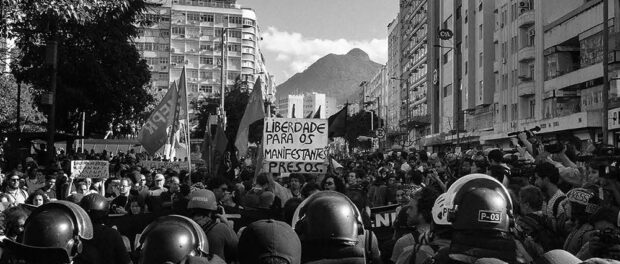
During the World Cup, 21 protestors were preemptively arrested in Rio on July 12, the day before the final. The arrests were justified by “the possible risk of future crime” without actually referencing any specific act or plan. On the day of the final, a protest took place in Rio’s Saens Peña Plaza, but police and National Guard surrounded the area and demonstrators were confronted with rubber bullets, smoke grenades and pepper spray, “in a scene lamentably resemblant of the oppression of the dictatorship.”
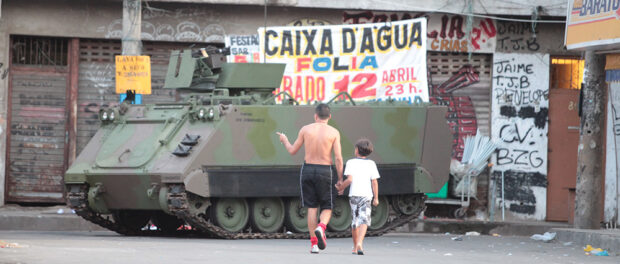
Away from the stadiums and fanfare, Brazil’s military crackdown was even more severe. The case study of Complexo da Maré is given as a most extreme example of repression in service of mega-events. The North Zone complex has been under military occupation since April 2014, with 16 residents killed in the first 15 days. Five months after the World Cup, the army occupation continues to define the World Cup legacy in Maré.
To download the full Mega-Events and Human Rights Violations in Brazil Dossier 2014 (in Portuguese) click here.

